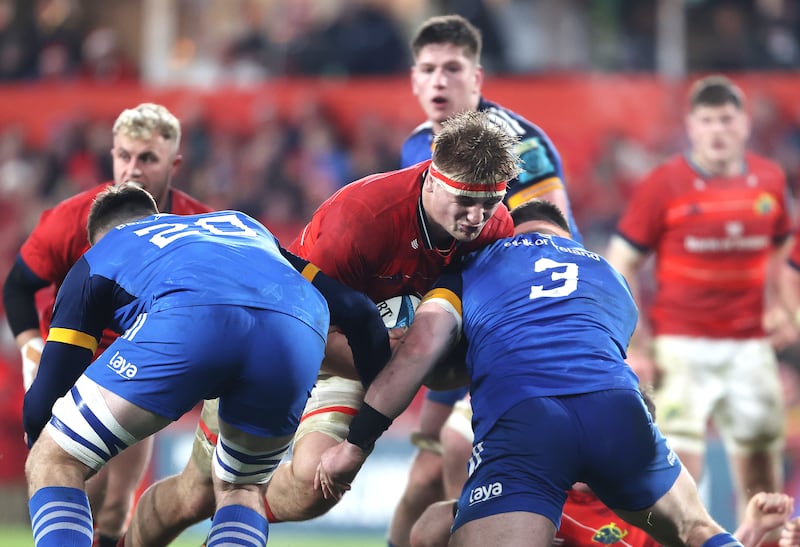Few pub chats kill as much time as naming players who should have more Ireland caps. On barstools around the country, Gavin Coombes’s name is frequently referenced.
Plenty of statistics point to his impressive provincial performances in recent years. Yet, aged 26, the Munster backrow finds himself in an era laden with high-quality Irish number eights: Caelan Doris (26), Jack Conan (32), Nick Timoney (29) and Cian Prendergast (24) were chosen to tour South Africa ahead of the Munsterman. Max Deegan, aged 28, is another competitor. Both he and Coombes are stuck on two Ireland caps.
On Saturday at Croke Park, four of those number eights will feature. In Belfast, Timoney and Prendergast will line up opposite each other. Andy Farrell surely values big performances against Ireland rivals when making selection decisions. When Ulster beat Leinster in the RDS last season, Timoney was a big influence. Does Coombes have a similar statement display to his name?
At this stage, the competition is to be the third-choice Irish number eight, such is the dominance of Doris and Conan. However, in a Lions year, with Ireland touring Romania and Georgia next summer, international caps should be easier to come by. At least one Irish eight will be on the Lions tour. Coombes, Deegan, Timoney, Prendergast – and perhaps Conan – will battle to add to their cap totals. Round one of that bout is this weekend’s interpros.
READ MORE
Based on the most recent Ireland squad, Timoney and Prendergast are ahead of Deegan and Coombes in Farrell’s pecking order. Positional flexibility may well have helped them earn selection for South Africa, but other factors would have also been at play. Last year’s stats may well offer some explanation.
Coombes’s workload and durability is often pointed to as a positive. Last season, Ruben van Heerden (Stormers) and Elrigh Louw (Bulls) were the only URC forwards to clock more domestic game time than Coombes’s 1,332 minutes of action. He was sixth in global club rugby, and first in the URC, for carries made (231). He also led the URC for successful carries, with 116. More than half of his carries were positive.
This season, despite only starting two of Munster’s three games, Coombes already ranks in the URC’s top 10 for carries (34) and carries over the gainline (15). Three games is a small sample size. How does this output compare to last year and, more importantly, other Irish number eights?
If you group Coombes with Deegan, Timoney, Prendergast, Conan and Doris, quantity over quality seems to be his modus operandi. According to Opta, his dominant carry rate from last season was the lowest of this group (32 per cent). Coombe’s gainline success rate (62.3 per cent) places him higher than Deegan and Prendergast, but still behind Timoney, Conan and Doris.
Gainline carries are exactly what they say on the tin. Dominant carries reflect that players often take passes well behind the gainline. The stat still rewards them for beating a defender in the collision, even if the ball is first thrown 10m behind the previous ruck.
Interestingly, Coombes shoots to the top of this group of players when looking at how often his carries drew in at least two tacklers (75.8 per cent). This suggests that the majority of his collisions come tight to the ruck, where defences have strength in numbers.

Plenty of other number eights carry in the wide channels where there is more space. Carrying closer to the ruck, into a number of big forwards rather than a smaller winger, makes it harder to dominate the collision. Coombes has also played secondrow for Munster, which will only add to his rate of carries close to the ruck.
Team-mates are also a vital consideration. Coombes is Munster’s primary ball-carrier. Leinster have three number eights on this list as well as the likes of Joe McCarthy, who has impressive carrying statistics. Sharing the load ensures different players can carry in more favourable positions, thus inflating their numbers, instead of one man continually taking on the harder carries.
Defensively, Coombes has a similar dominant tackle rate (6.5 per cent) to Timoney (6.3 per cent) and Prendergast (6.2 per cent). Doris (7.4 per cent), Deegan (12 per cent) and Conan (12.1 per cent) all have better numbers.
At the breakdown, Prendergast was the most effective domestic operator of this group last year. He was the best at disrupting opposition rucks (21.7 per cent effective) and second best at clearing out his own team’s breakdowns (91.9 per cent effective) – Doris (92.1 per cent) was the best. Coombes had the lowest figure for defensive breakdown effectiveness (11.8 per cent) and was third best when his side had the ball (91.5 per cent).
These numbers reflect different players having different strengths. It is up to the Ireland coaching staff to balance these into their desirable backrow depth.
Next year’s summer tour, with the Lions away, presents another selection dilemma. Does Simon Easterby, in charge while Farrell is in Australia, pick the next best players, or does he blood the younger generation already earmarked to replace the likes of Doris?
Prendergast is already seems to be ahead of Coombes in the pecking order and is two years younger than him. Leinster’s James Culhane is even younger again at 21. Having taken him on two Emerging Ireland tours, as well as naming him captain for Wednesday’s game against the Cheetahs, Ireland clearly rate Culhane.
Given the limited sample size – Culhane played 266 provincial minutes to Coombes’s 1332 – these numbers should be taken with a pinch of salt. But the young number eight had better stats than his Munster counterpart for dominant carries, gainline carries and carries drawing in at least two defenders.
For players such as Coombes, putting up decent numbers entering his prime years without earning Ireland recognition, the time to do the business or get off the pot is drawing near. A significant interpro performance on the eve of the November internationals would be as good a place as any to start.
- Sign up for push alerts and have the best news, analysis and comment delivered directly to your phone
- Join The Irish Times on WhatsApp and stay up to date
- Listen to our Inside Politics podcast for the best political chat and analysis




















